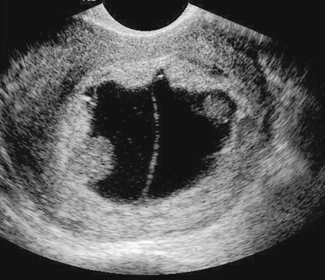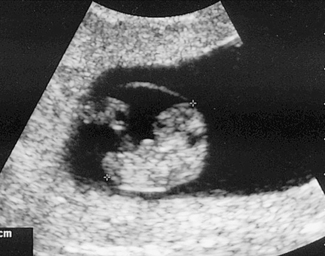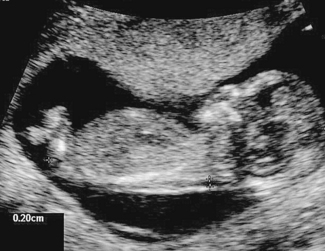Chapter 6 Antenatal care
AIMS OF ANTENATAL CARE
The aims of antenatal care are to ensure that:
DIET IN PREGNANCY
Many pregnant women are confused about what they should eat during pregnancy to make sure that they and their baby are properly nourished. What should a pregnant woman eat? To a large extent this will depend on her cultural background, her usual eating behaviour and her income level. As a general principle, women should be advised to eat a well-balanced diet that includes a sufficient amount of each of the five core food groups. It should be low in fat and high in fibre, with sufficient fresh fruit and vegetables, as is suitable for the general population and for her family. Although many women will eat slightly more during pregnancy there is no good evidence that they should drastically alter or increase their food intake. Table 6.1 shows the mean daily intake or RDI (recommended daily intake) that women should try to achieve. Table 6.2 shows what a pregnant woman should try to eat each day, translated into the foods a household buys.
Table 6.1 Recommended daily intakes
| RDA | See Note | |
|---|---|---|
| Protein | 51 g | * |
| Thiamin | 1.0 mg | * |
| Riboflavin | 1.5 mg | * |
| Niacin | 14–16 mg niacin equivalents | * |
| Vitamin B6 | 1.0–1.5 mg | * |
| Total folate | 400 μg | † |
| Vitamin B12 | 3.0 μg | * |
| Vitamin C | 60 mg | * |
| Zinc | 16 mg | * |
| Iron | 32–36 mg | ‡ |
| Iodine | 150 μg | * |
| Magnesium | 300 μg | * |
| Calcium | 1100 μg | * |
| Phosphorus | 1200 μg | * |
| Selenium | 80 μg | * |
| Vitamin A | 750 μg retinal equivalents | |
| Vitamin E | 7.0 mg α-tocopheral equivalents | |
| Sodium | 920–2300 mg | |
| Potassium | 1950–5460 mg |
* Indicates an increased requirement compared to non-pregnant female 19–54 years
† Daily requirement is doubled to 400 μg daily. RDI = 200 μg in a non-pregnant female 19–54 years
‡ RDI is expressed as a range to account for differences in bioavailability in foods. RDI is for second and third trimesters
| Carbohydrate foods | = | 4–6 servings |
| 1 serving | = | 2 slices bread |
| = | 1 cup cooked rice, pasta, noodles | |
| = | 1 cup porridge or 1⅓ cup cereal flakes | |
| Protein foods | = | 1½ servings |
| 1 serving | = | 100 g cooked meat or chicken |
| = | ½ cup cooked dried beans or peas | |
| = | 2 small eggs | |
| = | 120 g fish fillet or ½ cup tinned fish | |
| = | ⅓ cup nuts | |
| Milk and dairy foods | = | 3 servings |
| 1 serving | = | 250 mL or 1 cup of milk |
| = | 40 g or 2 slices cheese | |
| = | 1 carton/200 g yoghurt | |
| Fruit | = | 4 servings |
| 1 serving | = | 1 piece of fruit |
| = | ½ cup juice | |
| = | 1 cup canned fruit | |
| Vegetables | = | 5–6 servings |
| 1 serving | = | ½ cup cooked vegetables |
| = | 1 cup salad vegetables | |
| = | 1 potato | |
| = | ½ cup cooked dried beans/lentils | |
| Extras | = | 0–2½ servings |
| 1 serving | = | ½ chocolate bar |
| = | 1 slice cake | |
| = | 1 packet chips (crisps) |
Healthy women living in the industrialized countries whose haemoglobin is within the normal range and who eat a sensible diet usually do not require iron supplements. However, many women routinely supplement their diet with iron, as they may find it difficult to eat enough iron-rich foods and are at risk of iron deficiency. A protective factor in pregnancy is that dietary iron absorption is also increased. Iron-rich foods, such as red meat, legumes/pulses, wholegrain breads and cereals and fortified breakfast cereals, should be encouraged as well as including vitamin C-rich foods with those foods containing iron to aid in the absorption of iron. High-risk women in developed countries, such as: women on a limited budget; women with fad food behaviours or eating disorders; vegan/vegetarian women; and most women living in the developing countries require iron supplementation. This is discussed in Chapter 15.
ANTENATAL SCREENING
A great deal of prenatal care is spent in detecting potentially dangerous conditions early; screening is one strategy used. In its simplest form blood pressure measurement is a screening strategy, and is discussed later. Currently, much interest is being shown in screening for congenital defects, such as Down syndrome, neural tube defects and single gene defects, using DNA probes (Box 6.1).
Box 6.1 Possible indications for genetic diagnostic tests in first half of pregnancy
Screening for genetic defects
Screening for Down syndrome and certain other genetic defects (for example cystic fibrosis, thalassaemia, haemophilia, Huntington’s disease, some muscular dystrophies) can be carried out by chorionic villus sampling or amniocentesis. Before using these methods, an ultrasound examination of the fetus is made to exclude gross abnormalities (Figs 6.1–6.3).

Fig. 6.2 The scan shows an empty amniotic sac at 11 weeks’ gestation. The patient aborted 1 week later.





